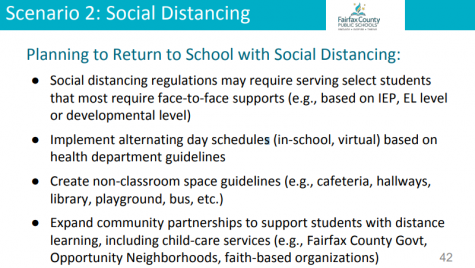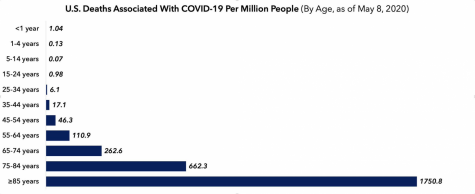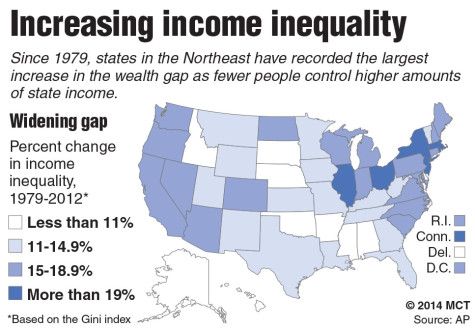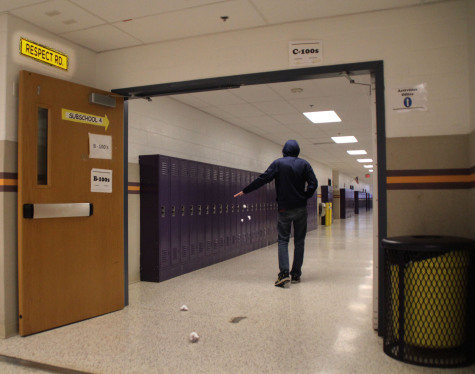Socially Distanced Classrooms Miss the Mark
The latest proposal from the Fairfax County school board is representative of a larger problem.

A first look at what socially distanced classrooms could look like. Photo courtesy of FCPS.
This story was last updated on May 28.
On Monday, May 18, Fairfax County Public Schools released a 47-page document titled “Returning to School: Options and Considerations for Summer and Fall 2020.” The document covers aspects spanning from Graduation plans to summer learning opportunities. Most noticeably, the report details the layout of three return-to-school scenarios. You can read through the scenarios here.
The most radical of these is ‘Scenario 2’, titled “Planning to Return to School with Social Distancing.”

Inside the report are pictures of what a socially distanced class would look like, with desks six feet apart and no more than twelve students in a single classroom at any given time. It also details social distancing within buses which, with students six feet apart, would reduce capacity by half for middle and high schoolers and two-thirds for elementary schoolers.
This scenario also mentions implementation of alternating day schedules, where students would presumably be learning from school one day and learning from home the next.
Yikes.
Let’s set aside the fact that the unemployment rate is the highest it’s been since the Great Depression and many families cannot afford to account for their children being home half the time.
Set aside the fact that the pandemic is already projected to add at least $10.3M to the FCPS payroll and this scenario would add on to that in a big way.
Set aside the fact that the year is 2020 and the second richest county in America does not have a secure way for students to learn remotely, such that they have to consider scenarios like this.
Set aside the fact that this plan would wholly change the way schools are run and what programs they could offer, what teachers could do or not do inside the classroom, and what every day activities would have to be altered.
Set aside the overall practicality of this plan.
What are we doing here?
Yes, none of this plan is concrete. At this point it’s no more than an idea. But just the mere fact that this is a real thing that is taking real time to be developed by real people is incredibly concerning.
This scenario is representative of how a portion of this country has chosen to respond to the coronavirus, a portion of which is inundated by decision makers who subscribe to fear-mongering.
I do want to make one thing clear. This isn’t a sole condemnation of FCPS. As is stated in the report, their ultimate decision will comply with the protocols Governor Ralph Northam and his medical experts decide. But releasing farcical scenarios like this promote a false narrative that we are going to live like this a lot longer than is actually necessary.
The latest guidance from the Centers for Disease Control and Prevention (CDC) on Friday included a “current best estimate” on the severity of the coronavirus. Its best guess for an overall case fatality rate is 0.4%, a number that falls to 0.05% for people under 50 years old. Knowing that your chance of contracting and dying from this virus is 0.05% you are under 50 and the overall death rate for the flu is 0.1%, are you really going to let THIS virus, of all things, change the way you live your life?
When you break this down even more using CDC data, you will find that a total of 88 people under the ages of 24 have died from the coronavirus. Break this down to under 14 years old and the number is 12. TWELVE. To put this in perspective, a total of 7591 people aged 0-24 have died since the week of March 21. When you do the math, that’s a rate of 0.0116 of total deaths in that age group that have been attributed to the coronavirus.

Furthermore, if you are between the ages of 1 and 24, as all FCPS students are, the chances of you contracting the coronavirus and dying from it are nearly one in 850,000 based on data from May 8. For comparison, the odds of you being struck by lightning are 1 in 700,000. If you are between the ages of 1 and 24 years old, you have a greater chance of getting struck by lightning than dying from the coronavirus.
If you are skeptical of such scientific studies and factual information, look no further than what’s actually been going on in the south. Several states have been open for near month now and have had a large amount of success. Florida, Georgia and Oklahoma, to name a few, have seen an overall declining trend in coronavirus deaths the last 30 days.
This virus is just like any other that has graced our planet. The longer the virus is prevalent, the more accurate our diagnosis of the virus’ behavior and tendencies become. Models that circulated earlier this year that we based the lockdown on proved to be wildly innacurate. 4% death rate? A million people dead? Wrong. Fortunately, most medical experts in the country have updated their files the last two months. Everyone else should do the same.
You look at the states that have yet to open and you have to wonder what more these decision makers need to see. The updated data is out there — if they choose to look at it. This virus is dangerous for the elderly, while having an incredibly minimal effect on the young and healthy. Certain governors have proven you can encourage those in high-risk categories to self-quarantine, those in low-risk categories to live their lives, and still see declining numbers.
Let’s bring this back to FCPS. If you are a teacher, student, administrator, janitor, etc. and you are in a high-risk group and feel unsafe, you should not go to school. If you feel sick, you should not go to school. If certain parents don’t feel comfortable with their students being at school, it’s well within their right to keep them home. All those unable to go to school can work remotely.
But when August comes around, high schools, middle schools, elementary schools and preschools need to swing open their doors to the overwhelming majority of the county’s students and staff that are ready to get back to work.
We need to hope that sooner rather than later, Fairfax County Public Schools, Virginia, and the rest of the fear-infested sector of the country update their files, set aside agendas, and get things back to normal.
If they don’t, the worst of the coronavirus controversy is yet to come.








